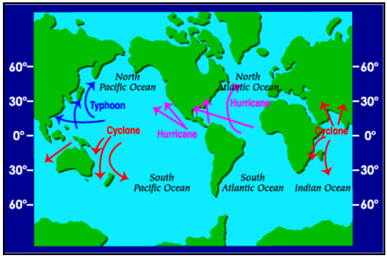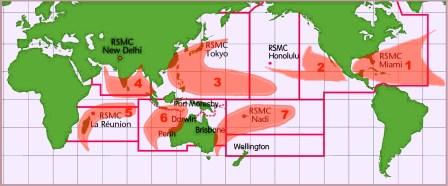In meteorology, a tropical cyclone, disturbance, depression, or storm, typhoon, or hurricane, depending on strength and location are types of low pressure systems which generally form in the tropics.
Hurricane is the ter m used to describe tropical cyclones that form near Central America, and they need the warm humid air above tropical seas in order to develop.
m used to describe tropical cyclones that form near Central America, and they need the warm humid air above tropical seas in order to develop.
Furthermore, they form only during the summer and early fall, when the tropical seas are about 80 degrees Fahrenheit or warmer. But you won’t normally see hurricanes form right at the equator. That’s because at zero degrees latitude there isn’t enough turning of winds in the atmosphere to give tropical cyclones the “spin” they need to get started.
This turning of the winds is known as the Coriolis Force or Effect.
Nearly all hurricanes form within 30 degrees of the equator and 87% form within 20 degrees. However, because the Coriolis effect initiates and maintains tropical hurricane rotation, such hurricanes rarely strike land less than 10 degree s from the equator. The Coriolis Effect initiates and helps maintain the rotation of a tropical hurricane. This rotational force is zero at the equator and increases as you travel away from the equator. Once a tropical storm is formed, wind determines its movement and there is very little cross-equatorial flow of wind, as the main winds steer the storm away from the equator.
s from the equator. The Coriolis Effect initiates and helps maintain the rotation of a tropical hurricane. This rotational force is zero at the equator and increases as you travel away from the equator. Once a tropical storm is formed, wind determines its movement and there is very little cross-equatorial flow of wind, as the main winds steer the storm away from the equator.
Also, hurricanes that form in the Caribbean are not likely to turn toward Costa Rica. Because Caribbean tropical storms normally are pushed northwest, along with the steering currents of trade winds from the east, then a clockwise flow of high pressure to the north. This has a tendency to turn them northward away from Costa Rica.
Costa Rica is located between 8 and 12 degrees north of the equator, below the path of most hurricanes.

There are seven tropical cyclone zones “basins” where storms occur on a regular basis and Costa Rica is not located in the affected areas.
